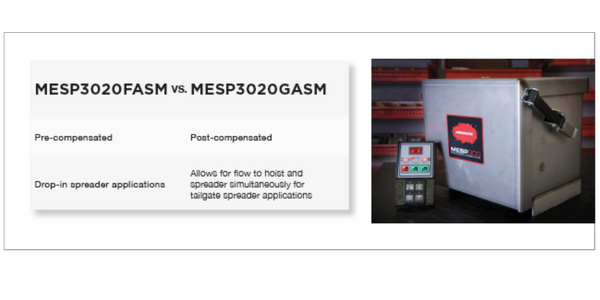The MESP3020
Featured in Muncie Power Quarterly, Issue 1, 2018
The Snow & Ice Division of Muncie Power Products operates at the cutting edge of technology and innovation as changes in the market demand a change in the products.
As a result, our snow and ice solutions range from tried-and-true, manually controlled central hydraulic systems to state-of-the-art, electronically controlled cartridge valve solutions with data logging, Wi-Fi connectivity for real-time diagnostic support, and GPS/ AVL mapping options.
To meet the changing marketplace, we have increased our options for Class 3, 4, and 5 work trucks. This article covers one of these options, and its versions, available for these popular truck sizes used by municipal, university, and landscaping fleets.
Popular on these sizes of work trucks, articulated plows usually come with their own DC power source and controls. So, what we did was bundle the hoist and spreader controls into a turnkey solution. This turnkey solution is the Muncie Electronic Spreader Package (MESP), specifically the MESP3020 and its versions—the MESP3020F and MESP3020G—which provide groundspeed control, both hoist and spreader control for drop-in, and tailgate spreaders respectively.
An electronic spreader package: The MESP3020
The MESP3020’s background menu has seven adjustable parameters including spinner minimum and maximum, auger minimum and maximum, retain settings and spinner blast, and spinner pause. Combined, these features conserve salt usage without compromising effectiveness. Our MESP3020 is easy to install and plumb. Since all of the controls are electric, harness routing into the cab can take whatever path is available. All of the SAE O-Ring hose connections are also on the bottom of the enclosure, keeping our frame rail footprint to a minimum.
Designed for underbody hoists, the MESP3020 delivers up to 6 GPM maximum flow to the hoist cylinder. Flow to the auger and spinner reaches 17 GPM and 8 GPM respectively.

System versions
The MESP3020FASM works with drop-in spreaders and is pre-compensated. On the other hand, the MESP3020GASM is post-compensated and allows for flow to the hoist and spreader simultaneously for tailgate spreader applications. The letters F and G tell whether the system is pre- or post-compensated.
Both come with either a powder-coated steel or stainless steel enclosure and weather-tight lid—which is denoted within the model number construction as ASM or ASM-SS.
Manual overrides are standard equipment. Relief valves and counterbalance valves are fully adjustable.
Where to use
The MESP3020 works well with Ford F-350, F-450, and F-550; Dodge 3500, 4500, and 5500; and Chevy/GMC 3500, 4500, and 5500. Hydraulic pumps can be power take-off or belt-driven depending on the engine and transmission available on your chassis.
 Why the MESP3020’s groundspeed control matters
Why the MESP3020’s groundspeed control matters
Salt usage concerns people at all levels. Use too little, roads remain slippery. Use too much, it wastes resources, damages concrete, and potentially affects the environment.
Over-applying salt commonly happens for two reasons. First, the operator, wanting to do a good job, applies a heavier application of salt than conditions demand. Second, the equipment may lack groundspeed control, resulting in changing application rates and piles of salt left at every stop the truck makes.
Without groundspeed control, the amount of salt applied per mile at 30 MPH is only one-third of the amount applied at 10 MPH. Conversely, proper application at 30 MPH is overkill at 10 MPH by a factor of three. With ground-speed control, you get an evenly applied layer of salt regardless of changes in truck speed and zero piles of salt left at stops.
With the all-electric MESP3020, featuring groundspeed control, the fleet manager can limit the driver’s range of control over application rates. In this way, the maximum is what the manager says, not what the driver selects.


